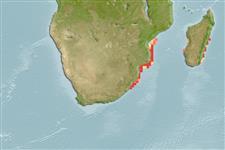Élasmobranches (requins et raies) (sharks and rays) >
Carcharhiniformes (Ground sharks) >
Pentanchidae (Deepwater catsharks)
Etymology: Halaelurus: halos (Gr.), sea; ailouros (Gr.), cat, probably an allusion to the vernacular “catshark,” so named for its cat-like eyes. (See ETYFish); lineatus: Latin for lined, referring to its 13 pairs of narrow dark-brown stripes. (See ETYFish).
Environment: milieu / climate zone / depth range / distribution range
Écologie
marin démersal; profondeur 0 - 290 m (Ref. 5510). Subtropical; 19°S - 31°S
Western Indian Ocean: Beira, Mozambique to East London, South Africa.
Taille / Poids / Âge
Maturity: Lm ? range ? - ? cm
Max length : 56.0 cm TL mâle / non sexé; (Ref. 244); 52.0 cm TL (female)
Description synthétique
Morphologie | Morphométrie
Épines dorsales (Total): 0; Rayons mous dorsaux (Total): 0; Épines anales 0; Rayons mous anaux: 0. A catshark with an upturned knob on the snout, a narrow head, and numerous small dark spots on the body (Ref. 5578). Pale brown with numerous pairs of narrow, vertical, dark brown stripes outlining obscure dusky saddles (Ref. 5578), cream below (Ref. 5510).
Found on the continental shelf and uppermost slope, on soft bottoms, from close inshore to 290 m (Ref. 5578). Feeds on small crustaceans, bony fish, and cephalopods (Ref. 5578). Although commonly caught by shore anglers, it is not generally considered a game fish (Ref. 12484).
Life cycle and mating behavior
Maturité | Reproduction | Frai | Œufs | Fécondité | Larves
Probably lays eggs, with up to 16 egg-cases per female; eggs retained until embryos reach advanced stage of development (Ref. 5578).
Compagno, L.J.V., 1984. FAO Species Catalogue. Vol. 4. Sharks of the world. An annotated and illustrated catalogue of shark species known to date. Part 2 - Carcharhiniformes. FAO Fish. Synop. 125(4/2):251-655. Rome: FAO. (Ref. 244)
Statut dans la liste rouge de l'IUCN (Ref. 130435)
Menace pour l'homme
Harmless
Utilisations par l'homme
Pêcheries: sans intérêt; pêche sportive: oui; Aquarium: Aquariums publics
Plus d'informations
RéférencesAquacultureProfil d'aquacultureSouchesGénétiqueElectrophoresesHéritabilitéPathologiesTraitementNutrientsMass conversion
CollaborateursImagesStamps, Coins Misc.SonsCiguateraVitesseType de nageSurface branchialeOtolithesCerveauxVision
Outils
Articles particuliers
Télécharger en XML
Sources Internet
Estimates based on models
Preferred temperature (Ref.
123201): 18.6 - 25.3, mean 22.7 °C (based on 22 cells).
Phylogenetic diversity index (Ref.
82804): PD
50 = 0.5078 [Uniqueness, from 0.5 = low to 2.0 = high].
Bayesian length-weight: a=0.00269 (0.00144 - 0.00502), b=3.05 (2.88 - 3.22), in cm total length, based on LWR estimates for this species & (Sub)family-body (Ref.
93245).
Niveau trophique (Ref.
69278): 4.5 ±0.60 se; based on food items.
Résilience (Ref.
120179): Faible, temps minimum de doublement de population : 4,5 à 14 années (Fec assumed to be <100).
Fishing Vulnerability (Ref.
59153): Moderate vulnerability (42 of 100).
